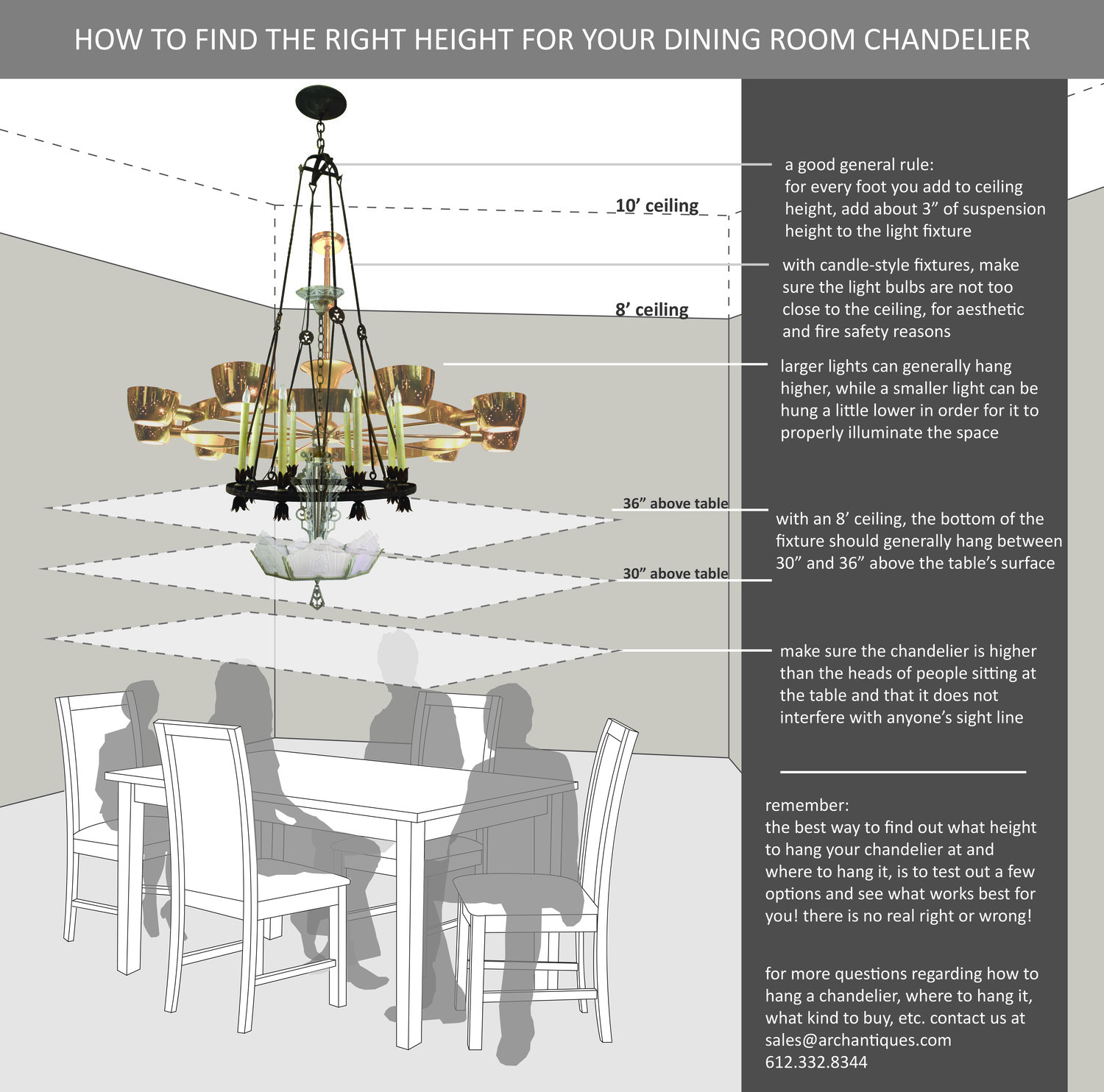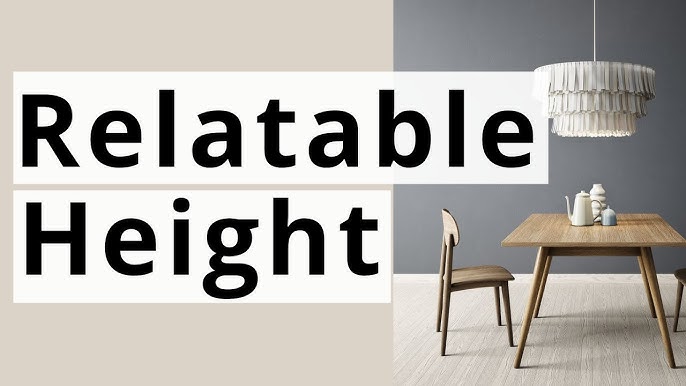When it comes to lighting your dining area, the height of your chandelier can make all the difference. You want it to look just right—neither too low to block your view nor too high to lose its charm.
But how high should a chandelier be hung over your table? Getting this perfect balance can transform your space, creating a cozy and stylish atmosphere for every meal. You’ll discover simple, practical tips to hang your chandelier at the ideal height, making your dining experience both beautiful and comfortable.
Keep reading to find out how to get it just right for your home.

Credit: www.1800lighting.com
Ideal Height Above Dining Table
Finding the ideal height for a chandelier above a dining table is key. It affects both the room’s look and how comfortable the space feels. The right height brings balance and beauty. It also ensures good lighting without glare or shadows.
Standard Measurement Guidelines
Most experts suggest hanging the chandelier 30 to 36 inches above the table surface. This range works well for ceilings that are 8 feet high. It allows enough space for heads and hands without blocking the view across the table.
For taller ceilings, keep the same distance from the table, not the floor. This keeps the light focused where it is needed. The chandelier should be low enough to create a cozy feel but high enough to stay out of the way.
Adjusting For Ceiling Height
Ceilings higher than 8 feet need a bit of adjustment. Add about 3 inches of height for every extra foot of ceiling height. For example, a 10-foot ceiling means hanging the chandelier 36 to 42 inches above the table.
This helps keep the chandelier proportional to the space. It also avoids the fixture hanging too low in a tall room. A chandelier that is too high can look lost and fail to light the table properly.
Considering Table Size And Shape
The table’s size and shape affect chandelier height too. Larger tables need a chandelier to be hung slightly higher to cover the surface. Smaller tables require the fixture to be closer for better light focus.
For rectangular tables, center the chandelier lengthwise and hang it slightly lower. Round tables allow for a chandelier hung in the middle at standard height. Always make sure the chandelier is not wider than two-thirds of the table’s width.

Credit: s3da-design.com
Factors Affecting Hanging Height
Determining the right height to hang a chandelier over your table isn’t just about measurements. Several factors come into play that affect both the look and function of your lighting. Understanding these elements helps you create a balanced space that feels comfortable and inviting.
Room Dimensions And Layout
The size and shape of your room influence how low or high the chandelier should hang. In a small room with low ceilings, you want to avoid hanging the chandelier too low to prevent blocking sightlines or bumping heads.
For larger rooms or those with high ceilings, a chandelier can hang lower to create a cozy atmosphere. Consider the table’s size too; a bigger table needs a larger chandelier hung slightly lower to maintain proportion.
Purpose And Ambiance
Think about what you use your dining area for. Is it mainly for quick meals, or do you host long dinners and conversations? The chandelier’s height affects how light spreads across the table and the mood it sets.
If you want bright, even lighting for tasks like reading or working at the table, hang the chandelier a bit higher. For softer, intimate lighting that encourages relaxation, lowering it can help create that ambiance.
Type And Style Of Chandelier
The design of your chandelier plays a big role in deciding the hanging height. A large, ornate chandelier with multiple tiers looks best when hung higher to avoid overwhelming the space.
On the other hand, a slim, modern fixture can be hung lower without making the room feel crowded. Remember, the style should complement your table and room without obstructing views or movement.
Measuring And Installation Tips
Measuring and installing a chandelier at the right height creates balance and style. Accurate measurement prevents the fixture from hanging too low or too high. Proper installation ensures safety and enhances the room’s look. Follow simple tips and use the right tools for the best result.
Tools Needed For Accurate Measurement
- Tape measure: For precise height and distance checking
- Step ladder: To reach ceiling and fixture safely
- Level: To ensure the chandelier hangs straight
- Pencil and paper: To note down measurements
- Assistant: Helpful for holding tools and confirming measurements
Step-by-step Installation Process
- Turn off power at the breaker to avoid electric shock
- Measure from the tabletop to the ceiling height
- Calculate the ideal chandelier height based on room size
- Mark the ceiling spot for the fixture center
- Install the mounting bracket securely to the ceiling
- Connect the wires carefully following safety guidelines
- Attach the chandelier and check its balance with a level
- Adjust the chain or rod length to achieve the right height
- Turn power back on and test the light
Common Mistakes To Avoid
- Hanging chandelier too low, blocking sight or movement
- Ignoring ceiling height and room size when measuring
- Failing to turn off electricity before installation
- Skipping the use of a level, causing uneven hang
- Not securing the mounting bracket properly
- Overlooking wire connections, risking electrical hazards
- Neglecting to test the light after installation
Special Cases And Variations
Ceiling height and table size can change the ideal chandelier height. Larger rooms may need higher placement, while smaller spaces call for lower hanging lights. Personal style and chandelier design also affect the best position above the table.
When it comes to hanging a chandelier over a table, there are several special cases and variations that you might encounter. These can affect the height and style of your chandelier installation. Understanding these nuances can help you create the perfect lighting arrangement for your space.Chandeliers Over Kitchen Islands
Hanging a chandelier over a kitchen island requires a different approach than over a dining table. You’ll want to ensure enough clearance for daily activities, which might include cooking and socializing. A good rule of thumb is to hang the chandelier so that the bottom is 30 to 36 inches above the island surface. Consider the size and shape of your island. A larger island might benefit from multiple smaller chandeliers for balanced lighting. This setup not only enhances illumination but also adds a stylish touch to your kitchen decor.Lighting Over Rectangular Vs. Round Tables
The shape of your table significantly influences the chandelier’s placement and height. For a rectangular table, a linear chandelier or a series of pendant lights can provide even lighting across the entire surface. Ensure that the fixture spans about two-thirds of the table’s length for optimal balance. Round tables, on the other hand, are best complemented by a central chandelier. This creates a focal point and evenly distributes light. The chandelier should hang at a height that allows unobstructed views across the table, encouraging conversation and connection.Adjusting For Multiple Light Fixtures
Multiple light fixtures can add a dynamic flair to your space, but they require careful consideration. If you’re using several chandeliers or pendant lights, ensure they are spaced evenly. This prevents overcrowding and ensures a harmonious look. Varying the height of these fixtures can add visual interest and depth. However, maintain a consistent distance between each fixture and the table to avoid a chaotic appearance. Have you considered how the lighting’s color temperature might affect the room’s ambiance? These special cases and variations offer opportunities to tailor your chandelier setup to your specific needs. By paying attention to these details, you can achieve a beautifully lit space that perfectly complements your home’s aesthetic.Enhancing Room Aesthetics
Choosing the right height for your chandelier above the table does more than just light the space—it shapes the entire room’s look and feel. A well-positioned chandelier can create a focal point that draws the eye and enhances the room’s style. It’s about making the chandelier work with the rest of your space to highlight your decor and create a welcoming atmosphere.
Pairing With Other Lighting Sources
Think about how your chandelier fits with other lighting in the room. If you rely solely on your chandelier, the light might feel harsh or uneven. Adding wall sconces, table lamps, or recessed lighting helps balance the illumination and creates layers of light.
Try dimmers on your chandelier and other lights to adjust mood and brightness easily. This way, your chandelier doesn’t overpower but complements other sources. How does your current lighting setup make you feel during different times of the day?
Balancing Light Intensity
The height at which you hang your chandelier affects how bright or soft the light feels on your table. Hang it too low, and the light might be intense and glaring. Too high, and the room might feel dim and disconnected.
Consider bulbs with adjustable brightness or warmer tones to soften the glow. Your goal is to create enough light for activities without causing discomfort. Have you tested different heights to see which feels most natural to your eyes?
Decor Tips Around The Chandelier
Use the chandelier as a centerpiece for your table’s decor. Surround it with elements that echo its style—like matching candle holders, a complementary centerpiece, or textured placemats. This creates harmony and makes your space feel thoughtfully arranged.
Don’t forget the ceiling and wall space around the chandelier. A painted ceiling medallion or a subtle wallpaper pattern can draw attention upward and enhance the chandelier’s presence. What small details around your chandelier can you tweak to elevate your room’s overall look?

Credit: www.archantiques.com
Frequently Asked Questions
How High Should A Chandelier Hang Over A Dining Table?
A chandelier should hang 30 to 36 inches above the dining table surface. This height provides balanced lighting and clear sightlines, creating a cozy yet functional atmosphere.
Does Ceiling Height Affect Chandelier Hanging Height?
Yes, higher ceilings require chandeliers to hang slightly higher. For ceilings above 8 feet, add 3 inches of hanging height per additional foot of ceiling height.
What Size Chandelier Suits Different Table Sizes?
Choose a chandelier diameter about half to two-thirds the table width. This proportion ensures the fixture complements the table without overwhelming the space.
Should Chandelier Height Vary For Different Room Styles?
Yes, modern rooms often favor lower-hung chandeliers, while traditional rooms suit higher placements. Adjust height to match the room’s style and scale for best impact.
Conclusion
Choosing the right height for a chandelier makes your room feel balanced. Hang it too low, and it blocks views. Too high, and it loses charm. Aim for about 30 to 36 inches above your table. This lets light spread well and keeps the space open.
Remember, the chandelier should match your room’s size too. With these tips, your dining area will look inviting and bright. A well-placed chandelier adds warmth and style to every meal. Simple adjustments can make a big difference.





